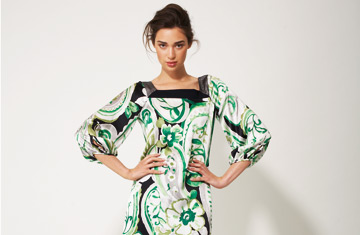
Dress design by Schumacher
Picture a wooden deck overlooking the Old Rhine River, neat rows of silver birch trees behind you and a vast plate of vegetable gratin being served in front of you. This is not your typical German organic restaurant; rather, it's the very elegant canteen at Schumacher, one of Germany's up-and-coming clothing brands, often referred to as the fashion insider's secret.
Co-owner Dorothée Schumacher-Singhoff, 41, runs the business with her ex-husband Jorg Singhoff out of a former paper mill in Mannheim. Designed by French architect Yves Bayard, the industrial-style headquarters is divided into two floors—upstairs creative, downstairs commercial. The fact that Schumacher-Singhoff-—a slim, chiseled beauty and mother of four—calls herself "heart of the company" on her business card indicates just how the organization is run. Rarely in her own office, she is always in another department brainstorming. "My team does the design, and I fire them up," she says. And although she employs 78 people on her international staff, Schumacher-Singhoff insists. "We're like a family here."
Schumacher-Singhoff began producing collections in 1989 with just three T shirts. Feminine and quirky, they were her way of rebelling against what she perceived of as 1980s-style businesswomen "dressing like men." Snapped up by Munich specialty store Therese, the brand then "grew on German market request." When pullovers were in demand the following season, Schumacher-Singhoff supplied them. Today Schumacher produces four collections a year, and the line—-known for translating the trends into wearable pieces, including silk parka-like dresses, heavy knit jackets and asymmetrical jackets with patent-leather details—is carried by stores like New York City's Bergdorf Goodman and Los Angeles' Fred Segal Flair. Jeannine Braden from Fred Segal Flair describes Schumacher as "one of those under-the-radar brands" that are reasonable in price and excellent in quality and as "an unexpected surprise" for her customers.
Lacking formal fashion training, Schumacher-Singhoff says success was achieved in part because she spoke fluent Italian. "I used to give my ideas to a woman in an Italian factory who would translate them on her sewing machine," she says. "It was a bit like having a secretary who turns your thoughts into a good letter."
Cut to almost 20 years later, and Schumacher's collections of jackets, suits and dresses include up to 300 pieces, in addition to a budding accessories line. The clothes are manufactured in different places around the world-—silks come from Hong Kong, fabrics are bought in Italy, and "petits mains" come from Eastern Europe—and undergo strict quality control when they come back to the warehouse near Mannheim. Each piece is carefully reviewed for quality by production experts whom Schumacher-Singhoff affectionately calls "the mothers of the pieces."
There is also intensive sales training prior to each season. "The design team has to explain its work to the sales department," she says, "and if you're a Schumacher girl, you can answer every question." Schumacher-Singhoff refers to the two-day reunion as "going back to school" but senses that "the clients feel better when there's one voice."